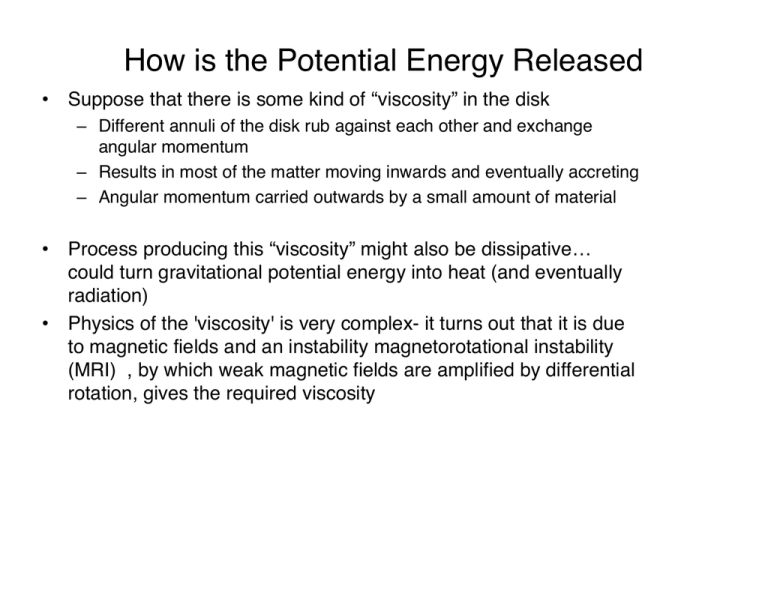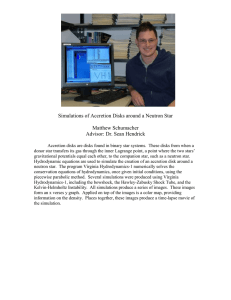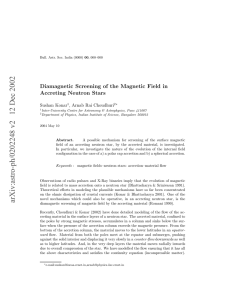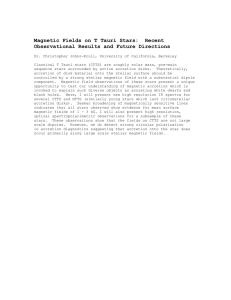How is the Potential Energy Released
advertisement

How is the Potential Energy Released • Suppose that there is some kind of “viscosity” in the disk – Different annuli of the disk rub against each other and exchange angular momentum – Results in most of the matter moving inwards and eventually accreting – Angular momentum carried outwards by a small amount of material • • Process producing this “viscosity” might also be dissipative… could turn gravitational potential energy into heat (and eventually radiation) Physics of the 'viscosity' is very complex- it turns out that it is due to magnetic fields and an instability magnetorotational instability (MRI) , by which weak magnetic fields are amplified by differential rotation, gives the required viscosity General Considerations • The luminosity that results from accretion is roughly – L~ εc2 M (dM/dt= M) Where ε=GM/Rc2 (the depth of the potential) • ε~3x10-4 for a white dwarf and 0.1 for a neutron star • If the gas flow is spherically symmetric and steady state the luminosity should not exceed the Eddington limit (outward force from Compton scattering balances gravity) • Two natural temperatures – Free fall kT=3/16 εmhc2=2x105ε kev – Black body temperature: minimum temperature for the object to radiate the observed luminosity • TBB~(L/Aσ)1/4 ; A is the area and σ is the Stefan-Boltzman constant • about 0.2 keV for a white dwarf and 2 keV for a neutron star General Considerations • Time scales: τdyn = (r3/G M)1/2 This is about 0.1 ms for matter at r = 10 km, and 2 ms at r = 100 km. The typical orbital period of circulating matter, Porb = 2π τdyn ~1 ms: • Characteristic velocity is ~(GM/R )1/2 ~ 0.5c. • The two main accretion mechanisms are – Roche lobe over flow, which most often occurs in low-mass binaries (LMXB,low B field, accretion disk and boundary layer dominated) – and stellar wind capture, which is common for high-mass binaries with super-giant companions (high B fields, pulsars) Basics of Accretion • Because of angular momentum considerations an accretion disk, almost always forms • Matter is thought to form a physically thin (but optically thick* disk) which has Keplerian rotation • Matter falls into by losing angular mometum via viscosity the angular velocity is Ωk=sqrt(GM/r3) The binding energy of a parcel of the disk is E=GMdiskMx/2R= 1/2 Lacc The other half of Lacc is released very close to the star surface (the boundary layer) as matter in the disk tries to co-rotate with the NS (what happens for a black hole??) If the star spins more slowly than the innermost part of the accretion disk (angular speed ωk) , the BL must release a large amount of energy as the accreting matter comes to rest at the stellar surface. Some of this is used to spin up the star, but there remains an amount GMMx/2R(1- ωk/Ωk)2 which is radiated * Optically thick means that a photon emitted inside the disk always interacts with matter at least once before 'escaping' Masses of Compact Objects • • Masses of neutron stars cluster around 1.4M (1 is near 2 M) other sources are galactic black holes Accreting Neutron Stars-Mass transfer Fuels Accretion, Creating X-rays • Two types- based on mass of companions – Low mass x-ray binaries-NS star tends to have low magnetic field (B~108-10 G)and accrete via Roche lobe overflow – High mass-NS tends to have high magnetic field ((B~1011-13 G), accrete from stellar wind • A bit about observations – LMXBs tend to be rather luminous and not show pulsations- spectra are ʻquasi-thermalʼ due to radiation from accretion disk and surface of NS – HMXBs are often ʻpulsarsʼ, spectra are non-thermal dominated by effects of energy generation and transfer in a high B field. Can measure B field via detection of cyclotron emission/absorption features. hωc/2π =heB/2πmec=11.6B12kev Effects of Geometry on Observed Properties can be Huge (P.Charles) Two Modes of Accretion Accretion from a stellar wind Accretion from Roche Lobe Overflow Cominsky (2002) HMXBs T. Kallman • Among the first discovered extra-solar sources (eg. Vela X-1, Cyg X-1, Cyg X-3, Her X-1) • Often contain pulsar • Often eclipsing • Pulse timing + stellar radial velocity +eclipses = mass, orbital separation, inclination determination • Accretion can occur from wind from primary, or from Rochelobe overflow • Two different subtypes: – Be binaries – Supergiant binaries • Statistics: ~50 known in galaxy • Young population, lifetime ~105 yrs: mass transfer is unstablewide range in luminosities High Mass X-ray Binary • The high mass companion sheds mass through a wind. • Wind flows isotropically from the companion, so a portion of it 'hits' the compact object. • This material is accreted and releases its potential energy as Xrays. HMXB- wind accretion From similar stars Observed X-ray luminosity Efficiency Guess: ~0.1 separation Lx~M wind c2G2M2η /(a2 vw4) Theory of wind accretion: (Davidson and Ostriker 1973): ρvw2/2 = GMρ/r Wind speed Accretion From a Wind • The process is called Bondi accretion • Consider a star of mass m, traveling through a gas of density ρ at relative velocity vrel. • Material inside a cylinder of radius racc=2GM/vrel2 can lose enough energy to fall onto the star at an accretion rate of S=πr2accvrelρf (where f is a fudge factor due to things not properly modeled due to radiation pressure effects and gas dynamics) giant stars stellar wind speeds are ~700km/sec giving racc~ 5x1010cm X-ray Pulsars • Accrete matter through wind or via disk from a high mass companion. Because of a large magnetic field strength (typically 1012 G) the material is channeled onto small spots at the magnetic poles. • the relativistically moving plasma is decelerated in a radiative shock near the surface and this subsonically settling plasma radiates in the X-ray band • Pulsations are observed if the magnetic field is inclined relative to the rotation axis. • Studies of the pulse profiles of individual pulsars allow one to constrain the emission pattern of the hotspots (or accretion columns) at the NS surface as well as the geometry of the magnetic field If the Magnetic Field is Strong (As In NS Pulsars) • • If magnetic pressure dominates over thermal pressure the magnetic field channels the accretion flow and matter flows along field lines that connect to the magnetic polar regions: As a result, almost all of the accretion energy is released in a “hot spot” near the two magnetic poles. If the magnetic axis is not aligned with the rotational axis, then as the star rotates we see more or less of the hot spot, and hence see pulsations in the X-rays. Cominsky (2002) Accreting Magnetic Neutron Stars • Effect of magnetic field – flow of ionized gas is channeled by the field – Photon production in a strong field is different (cyclotron radiation) • When/where does the magnetic field dominate the accretion flow? (C. Miller) The magnetic energy density is B2/8π, and the kinetic energy density of the accreting matter is 1/2ρv2, where ρ is the density and v is the typical velocity. Accreting Magnetic Neutron Stars By continuity, ρvff =dM/dt/(4πr2) (gas flow) (dM/dt=M ) Magnetic energy density =B2/8π Notice the radial dependences magnetic energy density goes as r −6 material energy density goes as r−5/2. Close to the star, magnetic stresses will dominate if the field is strong enough; A magnetic moment of μ30 = 1030 G cm3 which gives a surface field of ~1012 G is typical of neutron stars in high-mass X-ray binaries. Since the radius of a neutron star is R ≈ 106 cm, the accretion flow onto a strongly magnetized neutron star is dominated by the magnetic field. Where Does the Magnetic Field Start to Dominate? This is called the Alfvén radius The radius at which the pressure due to the pulsar's magnetic field equals the ram pressure of infalling material. If the magnetic field is dipolar, B = μ/r3, (μis the magnetic moment) and if the matter moves in spherical radial free fall v = vff =sqrt(2GM/r). So : ρvff =M /(4πr2) The free fall velocity vff =(GMx/2r)1/2 And the Kinetic energy Ekinetic=1/2 ρv2ff= M √GMxr-5/2/8π√2 The magnetic energy is • Emag =B2/4π=μ2/4πr6 • Balancing the two one finds that the Alfven radius is rA~(μ4/GMxM2)1/7 Or putting in typical numbers rA~3.2x108 M172μ304/7 M1/7 cm since a NS has a typical radius of 106 cm the magnetic field controls the flow at relatively large radii • Putting in typical numbers the radius where magnetic and material stresses are equal is the Alfven radius M17 is the accretion rate in units of 1017 gm/sec- why do we scale it this way?? Violation of Eddington Limit ?? • • • • • • The accretion rate of, ~ 0.1 the Eddington limited accretion rate falls onto a surface area only 10-3 of the star ! So the local flux generated >> Eddington limit For such accretion to persist, the radiation cannot escape back up the accretion funnel (remember the incoming material is interacting with the radiation for the Eddington limit to be defined). Instead the radiation has to come out where there is little or not accreting material (out the sides). The Eddington flux is a limit only for spherically symmetric systems, and in this case we have a system that is very aspherical the radiation pattern can be a “fan beam” (radiation escaping out the sides), so that we might get two peaks per cycle from the funnel (one from one side, one from the other) as opposed to the one peak we would expect if this were just a thermally glowing hot spot. Where is the Accretion Occurring • In a weak field neutron star (LMXB) has the accretion disk and the place where the material hits the star surface (boundary layer) produce the radiation Origin of Field ? • If the field is due to the 'original' star The fields in Main Sequence (MS) stars are ~1G. • For a MS progenitor of radius 4x1011cm (the sun has a radius of 7x1011cm) , (10M) the star would contain a magnetic flux of ~51023 Gcm2 (πr2B) • If flux is conserved during the collapse then a neutron star with the same flux would have surface field strength of 5x1011G, sufficient for a pulsar • However no one really knows if flux is conserved in the formation of the NS during the Supernova explosion and collapse and there are good reasons to believe that this is not true Eclipsing Pulsing Neutron Stars • A breakthrough in the understanding of these objects was the discovery of eclipses and pulse timing. Cen X-3 Eclipses Schreier 1972 Orbit • • • • • • Sign and phase of the pulses are due to the Doppler effect Amplitude of the sine pulse curve gives the size of the orbit (39.75 lt sec) with a 2.09 day orbit Eclipses are due to occultations of the NS by its companion Circular orbit from shape of time variation of pulses Get mass of system and orbital parameters Period of 4.8 sec shows that it must be a collapsed object (NS) Solution for Cen X-3 Measurement of Orbit Via Pulse Timing Mass of the NS Star • In order to measure the mass of the neutron star and its optical companion we need to measure the mass function. For a circular orbit it can be shown that this is defined MX =K3OP/2πGsin3i (1 +KX/KO)2 • MO and MX are the mass of the optical component and the X-ray source, respectively, i is the inclination • KX , KO are the semi-amplitude of the radial velocity curve for the x-ray and optical companion,respectively • P is the period of the orbit and i is the inclination of the orbital plane to the line of sight. •KX and P can be obtained very accurately from X-ray pulse timing delay measurements with Ko is measured from optical spectra for the companion Mass Function • F(m1,m2,i)=m31sin3i/(m1+m2)2 • Re-writing this as Mx=Fxq(1+q)2/sin3 q=ratio of the mass of the x-ray star to its companion • The delays in the observed arrival time of the pulses gives a2sini/c and the period thus F(m1,m2,i) The duration of the eclipse tells us about the star size • Using Newton's laws F(m1,m2,i)=(P/2πG(1-e2)3/2(v2sini)3 And F(m1,m2,i)=(4π2/GP2)(a2sini)3 Mx Where a2 is the orbital semi-major axis of star 2, v2sini is 1/2 the peak to peak orbital velocity of star 2 P is the period and e is the eccentricity Mop Davidson and Ostriker 1973 • For Cen X-3 he eclipse lasts 0.488 days out of the 2.1 day period or an opening angle of 43 degrees ((.488/2.1/)2). We know the mass function Mx 3 sini3/(Mx +M*)2=15 in this case) Mx ~1 Neutron Star Orbits Charles and Seward summary • X-ray binaries exhibit a wide range of behaviors, but much of the interesting physics/astrophysics is common to all • Understanding of accretion disks, accretion flows, X-ray induced winds, compact object evolution are all in an active state of research. Maximum Mass of a Compact object (Kalogera and Baym 1996) • • • • • The set of fundamental constraints, independent of the detailed physical properties of neutron matter, imposed on the equation of state of the inner core are (i) the mass density, ρ, is nonnegative, i.e., gravity is attractive; (ii) the pressure,P, at zero temperature is a function of ρ only, i.e., neutron matter is a fluid (iii) dP/dρ ≥ 0, -sound speed of neutron matter (dP/dρ)1/2 is real and matter is stable against collapse; (iv) the sound speed does not exceed the speed of light, i.e., dP/dρ≤ c2, hence signals cannot be superluminal and causality is satisfied. Under these conditions mass of NS Is maximum for 'stiffest' equation of state -the sound speed is the speed of light c2s =dP/dρ = c2. A huge amount of messy nuclear physics define the equation of state and it is not well understood. Using the equation of hydrostatic equilibrium in general relativity Maximum Mass (Cont) • None of the objects thought to be NS have a mass >2.4Msun but objects exist in the Milkyway way with a mass up to 19Msun Possible Equations of State of a NS Each line represents a different possible equation of statethe relationship between Pressure and density Maximum mass is ~3 M sun From website of Kaya Mori (CITA)





